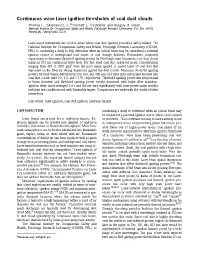Mining Publication: Continuous Wave Laser Ignition Thresholds of Coal Dust Clouds
Original creation date: August 2003
Laser-based instruments are used in areas where coal dust ignition presents a safety hazard. The National Institute for Occupational Safety and Health's Pittsburgh Research Laboratory is conducting a study to help determine when an optical beam may be considered a potential ignition source in underground coal mines or coal storage facilities. Researchers conducted experiments to determine threshold igniting powers for Pittsburgh Seam bituminous coal dust clouds using an 803-nm continuous wave laser. For fine-sized coal dust dispersed in air, concentrations ranging from 600 to 2,000 g/m3 were the most easily ignited. A heated layer of coal dust that deposited on the fiber tip during dispersion ignited the dust clouds. Minimum observed igniting powers for laser beams delivered by 200-, 400-, and 800-micrometer core fiber-optic cables and directed into coal dust clouds were 2.0, 3.0, and 5.0 W, respectively. Threshold igniting power was proportional to beam diameter, and threshold igniting power density decreased with larger fiber diameters. Ignition delay times averaged 0.6 sec and did not vary significantly with laser power under initially turbulent test conditions and with flammable targets. Comparisons are made with the results of other researchers.
Authors: TH Dubaniewicz, KL Cashdollar, GM Green
Peer Reviewed Journal Article - August 2003
NIOSHTIC2 Number: 20023572
J Laser Appl 2003 Aug 15(3):184-191
See Also
- Analysis of Mine Fires for All U.S. Underground and Surface Coal Mining Categories: 1990-1999
- Battery Safety Enhancements for Underground Coal Mines
- Coal Dust Explosibility Meter Evaluation and Recommendations for Application
- Coal Mine Explosion Prevention
- Lasers
- NIOSH Research for Monitoring and Controlling Methane at U.S. Underground Coal Mining Operations
- Refuge Alternatives in Underground Coal Mines
- Rock Dusting Considerations in Underground Coal Mines
- Safe and Economical Inerting of Sealed Mine Areas
- Ultra-Low Frequency Through-the-Earth Communication Technology
- Wireless Mesh Mine Communication System
- Content source: National Institute for Occupational Safety and Health, Mining Program


 ShareCompartir
ShareCompartir
